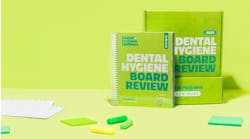by JoAnn R. Gurenlian, RDH, PhD
[email protected]
Recently, I have been paying attention to a term that I thought should have been, or perhaps was, abandoned years ago – the adage "cleaning teeth." I have noticed students using this term while working in clinic with their patients, as well as in papers they write for class assignments. Dental hygiene colleagues frequently tend to say they are "cleaning teeth" when they talk about their work.
When I was in dental hygiene school (in the dark ages), cleaning teeth was a familiar phrase that was used with our patients. I know I often referred to that at my job when working with patients in clinical practice settings. However, as the profession gained more experience, and we gained more confidence, I was under the impression that we stopped talking about cleaning teeth and focused on the many facets of dental hygiene care.
Recently, I had my students develop a treatment plan for a case study in which the patient had experienced a stroke and subsequent seizure disorder. The treatment plan was divided into four phases: assessment, therapy, maintenance, and referral.
The students identified multiple assessment areas, including reviewing the patient's medications and the need for laboratory testing prior to providing any dental hygiene care; the need to evaluate the motivation and ability of the patient with respect to how his physical limitations might impact the home-care regimen; the need to take vital signs before, during, and after the appointment and to know the signs of a stroke to monitor for signs of a medical emergency; as well as the need to anticipate a seizure and ways to manage it during an appointment.
The therapy aspect of the treatment plan focused on oral debridement and management of gingival hyperplasia associated with the use of antiseizure medications. Anticipating potential bleeding problems and having materials readily available was discussed. Maintenance included scheduling a reevaluation appointment to note progress made with the patient's gingival hyperplasia and bleeding concerns, ability to perform home-care procedures, and review of biofilm management.
Regarding referrals, the students identified the need to refer the patient to an occupational therapist to address some of the physical limitations and to collaborate on modifications needed for the patient's oral home-care procedures; working with a registered dietician to ensure that he was maintaining proper nutrition during recovery as it appeared the patient was favoring a softer diet; and, encouraging the patient to maintain his regular follow-up appointments with the neurologist.
As part of the learning exercise, we talked about the patient having a stroke during the dental hygiene appointment and how to manage this medical emergency. One student inquired when another appointment could be scheduled to "clean the patient's teeth." It was like listening to nails on a chalkboard. It was also like experiencing an epiphany.
Cleaning teeth? Really? We had just reviewed a myriad of dental hygiene functions and responsibilities that reflected critical thinking, decision making, accountability to the patient and the practice, management of a medical emergency, and working collaboratively with other health-care providers. Somehow, this was all summarized as "cleaning teeth."
We definitely have a problem understanding what it is we do and how to communicate that to our health-care colleagues and patients. No wonder we are often reduced to terms like the "cleaning lady" and the "tooth fairy." Charming as that may seem at times, it leaves a negative impression about dental hygienists.
Dentists do not "clean" caries from teeth; they restore teeth. Wisdom teeth are extracted. Biopsies are performed, not "scrapings of tissue." Periodontists surgically and nonsurgically debride biofilm from teeth and treat diseased gingival complexes. Of course, dentists do many important functions, but do we think of them as tooth cleaners or tooth keepers? Do their patients? NO! Patients will say, "I have a dental appointment." "I am getting a root canal." "My wisdom teeth are being removed." "I have to see a periodontist for a gum problem."
Isn't it far past the time when our patients should be saying, "I have a dental hygiene appointment?" Or, "I am seeing my hygienist to improve the health of my mouth and to prevent disease."
We need to make a concerted effort to banish "cleaning teeth" from our vocabulary. Students and patients need to be taught that their dental hygiene appointment will include multiple assessments of their general and oral health, a dental hygiene diagnosis, a treatment plan that incorporates the varied facets of oral health care, and reevaluation appointments to monitor progress with their oral health status. Students need to learn to view themselves as health-care providers, equal to others. Patients need to learn the term "dental hygiene appointment."
OK, I can already see some of you rolling your eyes. You are probably thinking, "Get over it; this is what we do." Is that really true? Is that all you do? All day long? I doubt it.
Take some time over the next week and step outside yourself. Try to jot some notes about the many different functions you perform over a week's time period. Create a list of the skill sets you used to perform those duties. Ask yourself how many times you educated and informed your patients of the many procedures you were performing, and why. Did you talk about their "dental hygiene appointment" or "cleaning teeth"?
Then, go one step further. Ask your patients and the office staff how they perceive you. Do they know all the things that you do? Do they value you as a health-care provider? Good for you if your answer is yes. If not, think about what you are doing to give others the impression that you're the office cleaning lady (or man), and what you can do to change that perception.
If you want to be respected and valued as a health-care provider, you have to start by respecting yourself. Banish the cleaning lady who cleans teeth from your practice!
JoAnn R. Gurenlian, RDH, PhD, is president of Gurenlian & Associates, and provides consulting services and continuing-education programs to health-care providers. She is a graduate program faculty at Idaho State University, adjunct faculty at Burlington County College and Montgomery County College, and president-elect of the International Federation of Dental Hygienists.
Past RDH Issues





